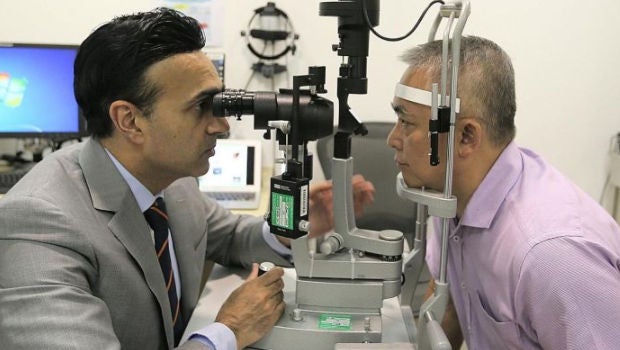
Associate Professor Jodhbir Mehta, head and senior consultant at SNEC's corneal and external eye disease department, with Mr Tan Beng Wee, who lived with pterygium for 30 years before going for Flaps last year. ST PHOTO: JONATHAN CHOO
By Lee Si Xuan, The Straits Times
More hospitals to offer this treatment for condition affecting 15.5% of population.
In July last year , Mr Tan Beng Wee became the first person in the world to undergo femtosecond laser-assisted pterygium surgery (Flaps).
Performed at the Singapore National Eye Centre (SNEC), the new laser surgical technique is used to treat pterygium, an eye condition that affects about 15.5 per cent of the population here. Pterygium is a benign fleshy wing-shaped growth that usually occurs in the inner or outer corners of the eye.
Since Mr Tan's surgery, 35 successful procedures have been performed at SNEC. Flaps will be rolled out in more hospitals next year.
For 30 years, the 61-year-old businessman lived with persistent discomfort and redness in both of his eyes and also had to contend with unsightly lesions.
A visit to the SNEC in 2014 found that he had pterygium. Left untreated, it could induce astigmatism and cause blurred vision.
"I was quite embarrassed when speaking and making eye contact with others. My eyes were always red and they made people so uncomfortable, some would even look away," he said.
Mr Tan repeatedly shelved plans to seek medical treatment till last year when the lesions became noticeably larger and began growing towards his pupils.
The condition is more commonly seen in tropical regions, like Singapore, and is caused by excessive exposure to ultraviolet light emitted by the sun.
The current gold standard for pterygium treatment - conjunctival autograft (CAG) - involves using tissue under the patient's upper eyelid and demands a high level of surgical skill and experience to obtain a thin graft. Complications are more likely to develop if a surgeon is less experienced.
Said Associate Professor Jodhbir Mehta, head and senior consultant at SNEC's corneal and external eye disease department: "When CAG is done manually, a considerable amount of skill is needed to cut an autograft as thin as possible and if it is too thick, chances of the pterygium recurring are much higher."
Flaps, however, uses the same laser technology commonly applied in cataract and Lasik surgery to precisely harvest an ultra-thin conjunctival graft - which can be easily achieved. It cuts the conjunctiva without leaving a scar, which cannot be achieved manually.
Flaps patients are less likely to redevelop pterygium lesions, with no recurrence cases reported in the 35 operations performed to date. An estimated 3 to 16 per cent of CAG patients experienced regrowth of the pterygium lesion.
Flaps costs about $200 to $300 more than existing pterygium treatment options. The SNEC performs an average of 500 pterygium procedures annually, with 346 performed last year.
The condition is more commonly seen in tropical regions, like Singapore, and is caused by excessive exposure to ultraviolet light emitted by the sun. So Mr Tan now dons wraparound sunglasses whenever he is outdoors.
"Those (who have pterygium) should quickly consult a doctor... The faster you do so, the faster you'll be free from the constant itchiness in your eye," he added.
SOURCE: THE STRAITS TIMES, SINGAPORE PRESS HOLDINGS LIMITED. REPRODUCED WITH PERMISSION.
Contributed by














 Get it on Google Play
Get it on Google Play